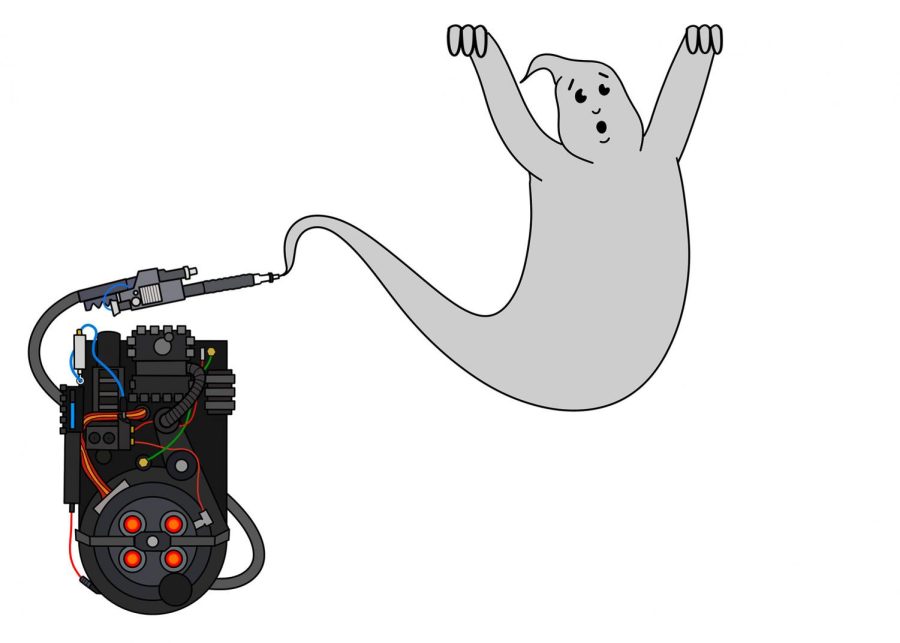Afterlife: The revival of the Ghostbusters
Graphic illustration by Jason Shan
Ghostbusters: Afterlife brings back nostalgia and inspires a new generation of fans.
December 7, 2021
The Ghostbusters series has long been eternalized as a witty, imaginative cinematic treasure, and its newest installment, Ghostbusters: Afterlife, has revitalized the nostalgic characters and features of previous movies.
In 1984, the first Ghostbusters movie became an instant cultural sensation thanks to its creative fusion of comedy, action and science fiction. Ghostbusters’ comedic icons of the 80s brought a light-hearted spirit to their battle against dangerous mythological evils. Marked with creative, paranormal technologies and the best special effects of the time, Ghostbusters has been revered as one of the most iconic movies in Hollywood.
The most recent film is directed by Jason Reitman, the son of the original Ghostbusters and Ghostbusters II director Ivan Reitman. Following the flop of Paul Feig’s 2016 all female Ghostbusters reboot in the box office, Reitman has successfully reclaimed his father’s legacy, bringing society’s bungling misfits and the ludicrous, fantastical horrors of ancient demons back to the big screen.
Ghostbusters: Afterlife follows the journey of Callie Spengler, a struggling single mom played by Carrie Coon, and her children Phoebe and Trevor as they move to their late grandfather Egon Spengler’s abandoned farmhouse in rural Oklahoma. Alongside their teacher, played by Paul Rudd, the children uncover the mystery of their grandfather’s sudden relocation and revive the Ghostbusters following a catastrophic, supernatural phenomenon that threatens the world.
Phoebe, played by young star McKenna Grace, is introduced as a nerdy preteen tomboy. Trevor, played by Finn Wolfhard of Stranger Things, parallels her character with his awkward attempts at capturing the eye of a small-town girl, Lucky. The addition of Lucky and Phoebe’s friend, Podcast, to the young Spenglers and Lucky rounds out a new generation reminiscent of the Ghostbusters’ core four.
Reitman’s film relies heavily on much needed nostalgia, closely paralleling many beloved scenes from the original Ghostbusters and resurrecting the same mythological villains. The movie brings back the classic Ghostbusters car and technologies in addition to rekindling the world’s love for the Stay Puft Marshmallow Man, arguably the movie’s most celebrated character. The revival of iconic scenes and characters has answered the prayers of all Ghostbusters fans, preserving the franchise’s landmark features and breathing fresh new life into the classic story.
Despite these glaring similarities to the original, disparities among the main characters are too noticeable. The 1984 Ghostbusters starred the best comedians of the time whose dry, jocular humor captured the love of fans and was unforgettable among fantasy horrors. In this movie, their young successors take stabs at whimsical banter, but fall back onto the stereotypical broody, outcasted characterization of teenaged movie characters today. In addition, rather than focusing solely on the daring pursuit of mystical ghosts, Ghostbusters: Afterlife diversifies unsuccessfully, languidly following the mediocre coming-of-age of young Phoebe Spengler and attempting to forge budding yet easily forgettable romances among characters.
The stars of the original Ghostbusters — Bill Murray, Dan Akyroyd and Ernie Hudson — reprise their legendary roles in this film, lovingly reflecting on their reckless days as Ghostbusters alongside the audience. The film features both a mid-credit and post-credit scene, in which memorable characters make reappearances that immerse the audience in wistful memory and leave them anticipating the future of the Ghostbusters.
Honoring the late Harold Ramis through his character Egon’s apparition and affection toward his family, the film pays homage to the actor by creating parallels between his nerdy, lovable character and his granddaughter’s, developing a sentimental connection between them.
The 1984 Ghostbusters was known for its captivating special effects, and this film mirrors them perfectly. Dodging any critique on the timeless, enthralling appearance of the supernatural in this film, the portrayal of ghosts and proton streams remain entirely unchanged despite the obvious growth in Hollywood special effects since the 80s. The whimsical nature of the franchise, however, is lost to the focus on the dark mystery behind mythological demons. Humor is a burden carried by only a few comedic relief characters.
Though strongly dependent on nostalgia, Ghostbusters: Afterlife revives the fading legacy of the Ghostbusters franchise, restoring the movie’s place in Hollywood history. As trends change with the decades, the original’s eccentric humor is regrettably replaced by today’s archetypal portrayal of teen crises and drama. Yet, answers to long-standing questions about the demons in the first Ghostbusters are presented, and the classic mythological apocalypse is brought to the big screen once more. Ghostbusters: Afterlife sets the stage for a new era of the franchise, and with its release, a new generation of fans are born.



































































